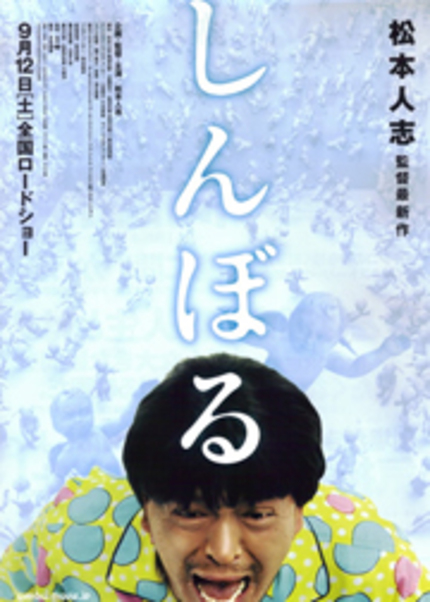NYAFF 2010: SYMBOL Review

Directed by and starring acclaimed
Japanese comedian Hitoshi Matsumoto, Symbol is a film with an interesting duality. On
the one hand, it is an existentialist exploration of cause and effect
on a grand scale, but it is also a low-brow comedy that is not afraid
to resort to dick and fart jokes. The closest comparison I can come
up with is two parts Luis Bunuel, a dash of Takashi Miike, and a
sprinkling
of Kevin Smith (to taste.) If it seems like I'm stretching to come up
with a cinematic analog, it's because I am. Matsumoto's followup to Big Man Japan
is a unique cinematic experience, and ponders life's big questions in
a way no other film has before it.
It all begins with a nun barreling
down US-15 in a rusted-out pickup truck. Well, probably not US-15, as
the scene takes place in Mexico, but that's what the watermark in the
upper right-hand corner of my screen told me. It is possible I was
looking
at a catalog number for some sort of screener tracking system, but who
knows. If I were to believe that, I would also have to believe that
the film was the property of Yoshimoto Kogyo Co., Ltd, because another,
more distracting watermark was emblazoned across the screen FOR THE
ENTIRE MOVIE. But I digress...
Cut to a Japanese man (played by
Matsumoto) with a haircut straight out of a Mexican soap opera as he
wakes up in an empty white room. He notices a small, phallic
protuberance
on the wall, and out of curiosity (not some unresolved, latent
homosexuality,)
he can't help but touch it. Hundreds of porcelain cherubs appear, only
to be absorbed back into the walls, leaving no evidence of their
existence
except for their tiny cock and balls. The walls are now covered with
them, and of course the man continues to tickle
Each and every manipulated member
elicits a unique tone, accompanied by the appearance of any number of
random objects. A toothbrush, sushi, an African native who runs across
the room- the notes form a scale and soon the room is filled with
assorted
bric-a-brac. One such tone causes a door to open in the otherwise secure
room, but the escape route is closed off as soon as the man's finger
is lifted. At this point, the film becomes an absurd version of Vincenzo
Natali's Cube, as the man attempts to utilize the objects
and penises in the room to facilitate his escape.
Some of the funniest sequences in
the film involve this elaborate prison break. I especially liked the
comic book style animatics used as the man formulates his plans. I am
not familiar with his work, but Matsumoto has finely honed comedic
chops.
He does err on the sophomoric side of humor, but there is an
undercurrent
of cerebricity to his silliness. The film can be frustrating at times,
especially when the character makes decisions like a teenager in a
slasher
flick, but is otherwise very entertaining.
Meanwhile, back in Mexico, (forgot
about Mexico, didn't you?) a pensive luchador prepares for an important
match. What could these two disparate scenarios possibly have to do
with one another? That, my friend, is one of the great mysteries of Symbol.
And when that mystery is revealed, and the two story-lines finally
converged,
my reaction was, "eh..." I see what the director was trying
to do, but It makes you question the whole point of spending so much
time on the luchador in the first place. The silliness of the Cube
half of the film invades the Mexico half, bringing its anti-realism
with it. This moment was my least favorite.
But then Symbol morphs into a full on art film, getting
all The Fountain on our collective ass. I won't go into
detail,
but it involves a bright, white light, and many more penises. And
President
Obama. It's actually kind of poignant.
Whether or not it all works for you
is another story. Symbol can be great fun. There is a charm to its
mixture of smart and stupid, and it possesses an element of daring
sorely
missing from Western cinema. Matsumoto is more than capable, both in
front of and behind the camera. He is equally successful working within
the constraints of the handheld, verite style of the Mexico scenes,
as well as the more refined, stylized Cube scenes. Both halves recall the work of Darren
Aronofsky, combining the influence of The
Wrestler and The Fountain into
one film. But this is not an Aronofsky film. It is a Matsumoto, through
and through. And if he continues making original amalgamations such
as this one, you might start hearing the films of young directors being
compared to his work.
Symbol screens Sunday, July 4th and Wednesday,
July 7th at Walter Reade Theater. Click here for more info and tickets!






